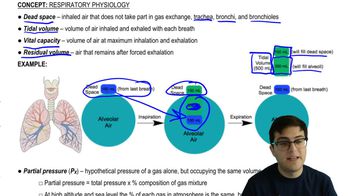Table of contents
- 1. Introduction to Biology2h 42m
- 2. Chemistry3h 40m
- 3. Water1h 26m
- 4. Biomolecules2h 23m
- 5. Cell Components2h 26m
- 6. The Membrane2h 31m
- 7. Energy and Metabolism2h 0m
- 8. Respiration2h 40m
- 9. Photosynthesis2h 49m
- 10. Cell Signaling59m
- 11. Cell Division2h 47m
- 12. Meiosis2h 0m
- 13. Mendelian Genetics4h 44m
- Introduction to Mendel's Experiments7m
- Genotype vs. Phenotype17m
- Punnett Squares13m
- Mendel's Experiments26m
- Mendel's Laws18m
- Monohybrid Crosses19m
- Test Crosses14m
- Dihybrid Crosses20m
- Punnett Square Probability26m
- Incomplete Dominance vs. Codominance20m
- Epistasis7m
- Non-Mendelian Genetics12m
- Pedigrees6m
- Autosomal Inheritance21m
- Sex-Linked Inheritance43m
- X-Inactivation9m
- 14. DNA Synthesis2h 27m
- 15. Gene Expression3h 20m
- 16. Regulation of Expression3h 31m
- Introduction to Regulation of Gene Expression13m
- Prokaryotic Gene Regulation via Operons27m
- The Lac Operon21m
- Glucose's Impact on Lac Operon25m
- The Trp Operon20m
- Review of the Lac Operon & Trp Operon11m
- Introduction to Eukaryotic Gene Regulation9m
- Eukaryotic Chromatin Modifications16m
- Eukaryotic Transcriptional Control22m
- Eukaryotic Post-Transcriptional Regulation28m
- Eukaryotic Post-Translational Regulation13m
- 17. Viruses37m
- 18. Biotechnology2h 58m
- 19. Genomics17m
- 20. Development1h 5m
- 21. Evolution3h 1m
- 22. Evolution of Populations3h 52m
- 23. Speciation1h 37m
- 24. History of Life on Earth2h 6m
- 25. Phylogeny2h 31m
- 26. Prokaryotes4h 59m
- 27. Protists1h 12m
- 28. Plants1h 22m
- 29. Fungi36m
- 30. Overview of Animals34m
- 31. Invertebrates1h 2m
- 32. Vertebrates50m
- 33. Plant Anatomy1h 3m
- 34. Vascular Plant Transport1h 2m
- 35. Soil37m
- 36. Plant Reproduction47m
- 37. Plant Sensation and Response1h 9m
- 38. Animal Form and Function1h 19m
- 39. Digestive System1h 10m
- 40. Circulatory System1h 57m
- 41. Immune System1h 12m
- 42. Osmoregulation and Excretion50m
- 43. Endocrine System1h 4m
- 44. Animal Reproduction1h 2m
- 45. Nervous System1h 55m
- 46. Sensory Systems46m
- 47. Muscle Systems23m
- 48. Ecology3h 11m
- Introduction to Ecology20m
- Biogeography14m
- Earth's Climate Patterns50m
- Introduction to Terrestrial Biomes10m
- Terrestrial Biomes: Near Equator13m
- Terrestrial Biomes: Temperate Regions10m
- Terrestrial Biomes: Northern Regions15m
- Introduction to Aquatic Biomes27m
- Freshwater Aquatic Biomes14m
- Marine Aquatic Biomes13m
- 49. Animal Behavior28m
- 50. Population Ecology3h 41m
- Introduction to Population Ecology28m
- Population Sampling Methods23m
- Life History12m
- Population Demography17m
- Factors Limiting Population Growth14m
- Introduction to Population Growth Models22m
- Linear Population Growth6m
- Exponential Population Growth29m
- Logistic Population Growth32m
- r/K Selection10m
- The Human Population22m
- 51. Community Ecology2h 46m
- Introduction to Community Ecology2m
- Introduction to Community Interactions9m
- Community Interactions: Competition (-/-)38m
- Community Interactions: Exploitation (+/-)23m
- Community Interactions: Mutualism (+/+) & Commensalism (+/0)9m
- Community Structure35m
- Community Dynamics26m
- Geographic Impact on Communities21m
- 52. Ecosystems2h 36m
- 53. Conservation Biology24m
40. Circulatory System
Gas Exchange
Problem 6`
Textbook Question
Frog lungs have a smaller surface area for gas exchange than mammalian lungs. How do frogs compensate for this difference?
a. Frog tissue absorbs more oxygen from the blood than mammalian tissue does.
b. Frogs breathe more quickly than mammals.
c. Frogs also obtain oxygen via diffusion across the skin.
d. Frog lung tissue has a greater density of capillary beds than mammalian lung tissue.
 Verified step by step guidance
Verified step by step guidance1
Understand the problem: Frogs have smaller lung surface areas compared to mammals, which affects their ability to exchange gases efficiently through their lungs alone.
Consider the options provided: Each option suggests a different mechanism by which frogs might compensate for their smaller lung surface area.
Evaluate option c: Frogs also obtain oxygen via diffusion across the skin. This is a known adaptation in amphibians, where cutaneous respiration allows them to absorb oxygen directly through their skin, supplementing lung respiration.
Compare option c with other options: While options a, b, and d suggest different physiological adaptations, option c is unique to amphibians and is a well-documented method of respiration.
Conclude that option c is the most plausible mechanism: Frogs use cutaneous respiration to compensate for their smaller lung surface area, allowing them to efficiently exchange gases through their skin.
 Verified video answer for a similar problem:
Verified video answer for a similar problem:This video solution was recommended by our tutors as helpful for the problem above
Video duration:
2mPlay a video:
Was this helpful?
Key Concepts
Here are the essential concepts you must grasp in order to answer the question correctly.
Cutaneous Respiration
Cutaneous respiration is the process by which some animals, including frogs, exchange gases through their skin. This adaptation allows frogs to absorb oxygen directly from the environment, compensating for the smaller surface area of their lungs. The skin must remain moist to facilitate this gas exchange, which is why frogs are often found in humid environments.
Recommended video:
Guided course

Anaerobic Respiration
Surface Area to Volume Ratio
The surface area to volume ratio is a critical factor in the efficiency of gas exchange. Frogs have a smaller lung surface area compared to mammals, which limits their ability to exchange gases through the lungs alone. By utilizing their skin for respiration, frogs increase their effective surface area for gas exchange, allowing them to meet their metabolic needs.
Recommended video:
Guided course

Surface Area to Volume Ratio
Adaptations in Amphibians
Amphibians, like frogs, have evolved various adaptations to survive in diverse environments. These include the ability to respire through both lungs and skin, known as bimodal respiration. This dual system allows them to thrive in both aquatic and terrestrial habitats, providing flexibility in oxygen acquisition depending on environmental conditions.
Recommended video:

Adaptive Radiation

 5:55m
5:55mWatch next
Master Gas Exchange and Breathing with a bite sized video explanation from Jason
Start learningRelated Videos
Related Practice





















